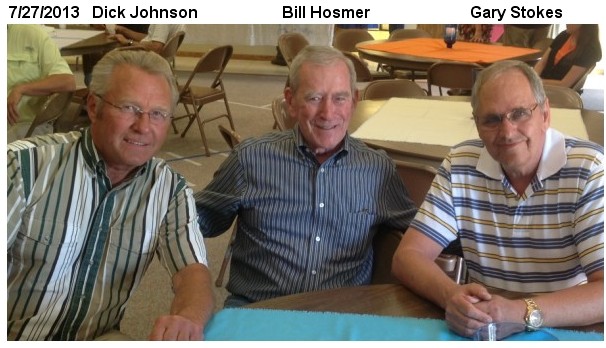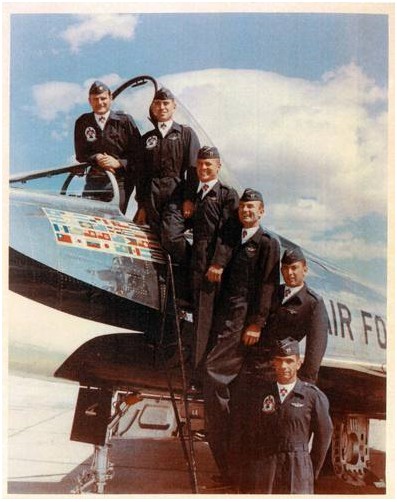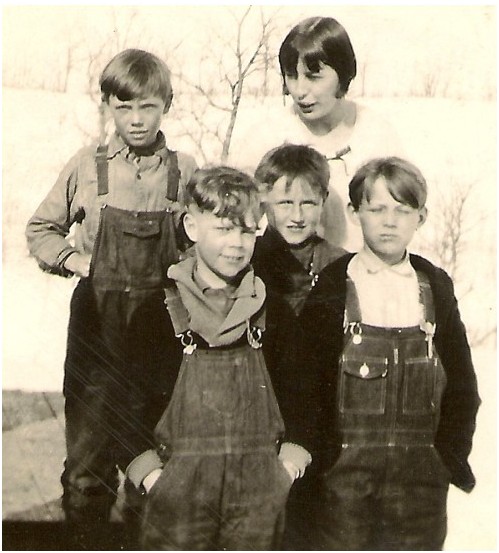Helmut Schmidt – Grand forks Harold – 07/04/2013
The native son of Dunseith, N.D., was one of the country’s top fighter jocks in the 1960s. The man who went by the call sign “Hoz” lived the philosophy of one engine, one pilot and go get the bad guys.
Hosmer, now 82, flew 240 combat missions in Vietnam, rising to the rank of colonel.
And he was a superb pilot, serving a tour as the “left wing,” – the No. 2 flier in the famed Thunderbirds – very likely the only North Dakotan ever to have flown with the red, white and blue precision flying group.
That was back when Congress wasn’t gridlocked. Sequestration wasn’t in the public’s daily lexicon. And America’s best pilots weren’t grounded on Independence Day for lack of funding.
Like other old soldiers, today he’ll seek out friends and peers – by email or telephone, or to raise a glass of beer – to remember those who died, and to honor flag and country.
“We know what it means to have served a country as great as ours,” Hosmer said. “There’s nobody as patriotic as a guy who’s served.”
Hosmer was born Oct. 17, 1930, in Rolette, N.D., but grew up in Dunseith.
He got his first airplane ride as a 2-year-old.
“My dad took me up in an open cockpit. I sat in his lap in the front cockpit in an old airplane at the opening up of the Peace Garden,” Hosmer said.
“They were selling dollar rides. That was my first ride, but I don’t remember,” he said.
What definitely left an impression was his uncle Clark L. Hosmer, who flew in the U.S. Army Air Corps and managed to use a couple of his airplanes to visit Dunseith before World War II. (He later flew B-25s during the war.)
That got young Bill hooked.
To get the higher math he needed to pass the exams for West Point, he lived with his uncle in the Twin Cities, graduating from St. Louis Park (Minn.) High School.
He spent a year in the Army as an enlisted man, then entered West Point, graduating in 1953. In those pre-Air Force Academy days, 25 percent of the class were commissioned Air Force lieutenants.
He started flying the F-86 Sabre, then in 1957, he became an F-100 Super Sabre instructor.
From January 1961 to July 1963, Hosmer, a captain at the time, flew left wing with the Thunderbirds.
“It was absolutely, probably, the most challenging flying, pure flying, that I had the opportunity to do,” Hosmer said. “It was fun to show off, fly low and buzz people’s towns.”
The F-100 was temperamental, difficult for new pilots, but fast. And the Thunderbirds flew it at air shows worldwide
In the book, “We Rode the Thunder,” Hosmer described just how hairy a Thunderbirds show could get:
“Snow flurries streaked by my canopy as we flew beneath low clouds at Minot AFB (Air Force Base), North Dakota. I glanced to my right and saw Bob Cass in the distance, closing fast at a right angle. Hoot Gibson was off to my left, Opposite Cass. One airplane was in (after)burner as it forced itself against the 50-knot wind. Another had its speed brake down as the wind pushed from behind. Bob Bell was ahead in another F-100 coming at me.
“He and I crabbed against the gale to keep it from blowing us to the side. We all headed for the same spot just feet above the earth in the maneuver known as the crossover.
“Bell and I met precisely on target, and as we did, we heard the engines of Gibson and Cass, as they crossed at right angles beneath us.
“We had just performed a perfect crossover under the most extreme conditions we’d ever seen. It was September 1961 in my home state of North Dakota, and where I learned the answer to “Why not, Minot??”
‘A different sort of memory’
In 1963, Hosmer flew F-105 Thunderchiefs, also known as “Thuds,” with the 18th Tactical Fighter Wing out of Okinawa, Japan.
The Mach 2 capable fighter-bombers were a workhorse early in the Vietnam War. The 18th TFW would regularly deploy to Korat, Thailand.
As a major, Hosmer led missions against surface-to-air missile sites, and the losses among the F-105 wings were significant.
In one picture Hosmer saved from that time, three of the five other men with him were shot down. One died, one was rescued and the third spent 7½ years as a prisoner of war.
“The combat time, it was a different sort of memory. Survival and trying to do your job, and bring back the people you go out with if you’re a leader,” he said.
In a second tour from 1969 to 1970, he flew F-100s as a lieutenant colonel with the 308th Tactical Fighter Squadron
He flew 240 combat missions, 60 in the Thud, and 180 in the F-100, he said.
His medals include a Silver Star, the Legion of Merit, the Distinguished Flying Cross, the Bronze Star and the Air Medal with 13 oak leaf clusters.
His last assignment was from 1973 to 1976 with the 355th Tactical Fighter Wing, flying A-7D Corsairs. The last two years he was the colonel in command.
He then flew 15 more years as a civilian, first for Cessna’s demonstration department and later as a corporate pilot.
Through all those years, he and his wife, Patricia (Small), raised a daughter and four sons. Bill and Patricia grew up together and married just after he graduated West Point. They were together 57 years, until she died in 2010.
Darrol Schroeder, a retired Air Force major general with contacts throughout the service, including the Thunderbirds, said he has not heard of another North Dakotan to have flown with the Thunderbirds.
Two other North Dakotans rose to the top of the military precision-flying with the Blue Angels, said Schroeder, an organizer of the Fargo AirSho. They are Gil Rud, of Portland, and Dave Stuart, of Minot.
Hosmer used to summer in North Dakota, but he now calls Tucson his full-time home.
He says there are times he still wishes he could strap on an F-100.
But since that’s not possible, he finds other ways to get his flying fix. In particular, as a passenger in a buddy’s Pitts Special.
As he puts it, the occasional ride in the aerobatics plane gives him just enough G forces “to clear the head.”
Congratulations Bob and Doreen.I was able to open the attachment with no problems that I have pasted below.Gary
In the first picture, Corbin is the tallest of the kids. The location is at the Achworth school. The picture was given to me by the teacher (the young woman in the picture). I’m sorry to say that I forgot her name. However, the name Skarpol keeps coming to mind.
Keith,I think you said your dad, Corbin, was born in 1918. He looks to be about 12 or so in this picture, so I am guessing it was taken in about 1930. In the Dunseith book on page 464 there is a list of all the teachers that taught at Ackworth. It is not in any kind of order, so I can not tell the years that each taught.In those years there were lots of Hiatt’s and a number of Bower’s and Hagen’s that attended Ackworth. Willis Bowers would have been in Ackworth during those years. He and Shirley are residences of Good Sam. I visited them when I was there last month. Willis may by able to identify all in this picture.Gary







